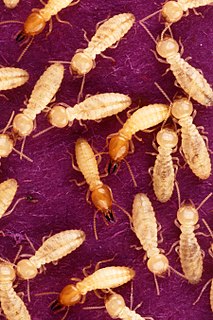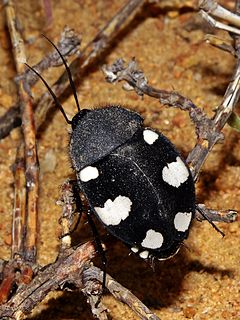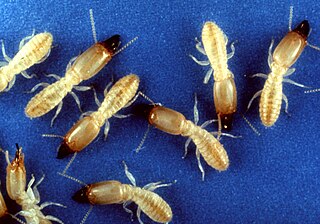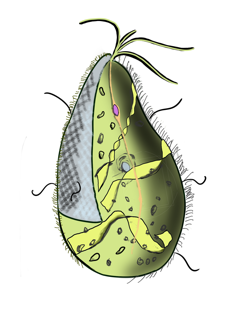Related Research Articles

Lynn Margulis was an American evolutionary biologist, and was the primary modern proponent for the significance of symbiosis in evolution. Historian Jan Sapp has said that "Lynn Margulis's name is as synonymous with symbiosis as Charles Darwin's is with evolution." In particular, Margulis transformed and fundamentally framed current understanding of the evolution of cells with nuclei – an event Ernst Mayr called "perhaps the most important and dramatic event in the history of life" – by proposing it to have been the result of symbiotic mergers of bacteria. Margulis was also the co-developer of the Gaia hypothesis with the British chemist James Lovelock, proposing that the Earth functions as a single self-regulating system, and was the principal defender and promulgator of the five kingdom classification of Robert Whittaker.

Termites are eusocial insects that are classified at the taxonomic rank of infraorder Isoptera, or alternatively as epifamily Termitoidae, within the order Blattodea. Termites were once classified in a separate order from cockroaches, but recent phylogenetic studies indicate that they evolved from cockroaches, as they are deeply nested within the group, and the sister group to wood eating cockroaches of the genus Cryptocercus. Previous estimates suggested the divergence took place during the Jurassic or Triassic. More recent estimates suggest that they have an origin during the Late Jurassic, with the first fossil records in the Early Cretaceous. About 3,106 species are currently described, with a few hundred more left to be described. Although these insects are often called "white ants", they are not ants, and are not closely related to ants.

The evolution of flagella is of great interest to biologists because the three known varieties of flagella – each represent a sophisticated cellular structure that requires the interaction of many different systems.

A spirochaete or spirochete is a member of the phylum Spirochaetota, which contains distinctive diderm (double-membrane) gram-negative bacteria, most of which have long, helically coiled cells. Spirochaetes are chemoheterotrophic in nature, with lengths between 3 and 500 μm and diameters around 0.09 to at least 3 μm.

Blattodea is an order of insects that contains cockroaches and termites. Formerly, the termites were considered a separate order, Isoptera, but genetic and molecular evidence suggests termites evolved from within the cockroach lineage, cladistically making them cockroaches as well. The Blattodea and the mantises are now all considered part of the superorder Dictyoptera. Blattodea includes approximately 4,400 species of cockroach in almost 500 genera, and about 3,000 species of termite in around 300 genera.

Reticulitermes flavipes, the eastern subterranean termite, is the most common termite found in North America. These termites are the most economically important wood destroying insects in the United States and are classified as pests. They feed on cellulose material such as the structural wood in buildings, wooden fixtures, paper, books, and cotton. A mature colony can range from 20,000 workers to as high as 5 million workers and the primary queen of the colony lays 5,000 to 10,000 eggs per year to add to this total.
Fibrobacterota is a small bacterial phylum which includes many of the major rumen bacteria, allowing for the degradation of plant-based cellulose in ruminant animals. Members of this phylum were categorized in other phyla. The genus Fibrobacter was removed from the genus Bacteroides in 1988.

Mixotricha paradoxa is a species of protozoan that lives inside the gut of the Australian termite species Mastotermes darwiniensis.
Methanobrevibacter cuticularis is a species of methanogen archaeon. It was first isolated from the hindgut of the termite Reticulitermes flavipes. It is rod-shaped, ranging in size from 0.34 to 1.6 µm and possesses polar fibers. Its morphology, gram-positive staining reaction, resistance to cell lysis by chemical agents and narrow range of utilizable substrates are typical of species belonging to the family Methanobacteriaceae. It habitates on or near the hindgut epithelium and also attached to filamentous prokaryotes associated with the gut wall. It is one of the predominant gut biota.
Methanobrevibacter curvatus is a species of methanogen archaeon. It was first isolated from the hindgut of the termite Reticulitermes flavipes. It is rod-shaped, ranging in size from 0.34 to 1.6 µm and possesses polar fibers. Its morphology, gram-positive staining reaction, resistance to cell lysis by chemical agents and narrow range of utilisable substrates are typical of species belonging to the family Methanobacteriaceae. It habitates on or near the hindgut epithelium and also attached to filamentous prokaryotes associated with the gut wall. It is one of the predominant gut biota.
Methanobrevibacter filiformis is a species of methanogen archaeon. It was first isolated from the hindgut of the termite Reticulitermes flavipes. It is rod-shaped and possesses polar fibers. Its morphology, gram-positive staining reaction, resistance to cell lysis by chemical agents and narrow range of utilisable substrates are typical of species belonging to the family Methanobacteriaceae. It habitates on or near the hindgut epithelium and also attached to filamentous prokaryotes associated with the gut wall. It is one of the predominant gut biota.
Methanobrevibacter gottschalkii is a species of methanogen archaeon, named after Gerhard Gottschalk.
Methanobrevibacter thaueri is a species of methanogen archaeon, named after Rolf K. Thauer.
Methanobrevibacter woesei is a species of methanogen archaeon, named after Carl R. Woese.
Methanobrevibacter wolinii is a species of methanogen archaeon, named after Meyer J. Wolin.
Diplocalyx is a genus of bacteria of the spirochete phylum. The genus was originally established in 1968 on the basis of differential morphology when compared to other spirochete species. No species within it has been successfully grown in culture. Up to now there is only on species of this genus known.
Pillotina calotermitidis is a species of spirochete that is symbiotic in wood-eating cockroaches and termites, the type species of its genus.
Hollandina pterotermitidis is a species of spirochete that is symbiotic in wood-eating cockroaches and termites, the type species of its genus.
Cryobacterium psychrophilum is the type species of the bacterial genus Cryobacterium. It is an obligately psychrophilic, Gram-positive irregular rod-shaped actinomycete.
Pterotermes is a monotypic genus of termites in the family Kalotermitidae. Pterotermes occidentis is the single species in the genus. This termite lives in the extremely dry conditions found in the Sonoran Desert in southwestern United States, Baja California and Mexico. It feeds on dry wood and lives entirely within a single piece of timber.
References
- ↑ Bermudes, D.; Chase, D.; Margulis, L. (1988). "Morphology as a Basis for Taxonomy of Large Spirochetes Symbiotic in Wood-Eating Cockroaches and Termites: Pillotina gen. nov., nom. rev.; Pillotina calotermitidis sp. nov., nom. rev.; Diplocalyx gen. nov., nom. rev.; Diplocalyx calotermitidis sp. nov., nom. rev.; Hollandina gen. nov., nom. rev.; Hollandina pterotermitidis sp. nov., nom. rev.; and Clevelandina reticulitermitidis gen. nov., sp. nov". International Journal of Systematic Bacteriology. 38 (3): 291–302. doi: 10.1099/00207713-38-3-291 . ISSN 0020-7713. PMID 11542253.